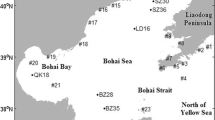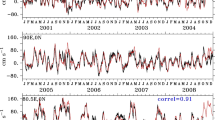Abstract
Oceanic current data in the warm pool region of the western equatorial Pacific measured by upward-looking moored Acoustic Doppler Current Profilers at two equatorial sites (147°E and 154°E) and two off-equatorial sites (2°N and 2°S, 156°E) during TOGA/COARE Intensive Observing Period (IOP) from November 1992 to February 1993 are used to examine short-term variabilities in the upper layer above 160–240 m. In time series of the zonal and meridional currents in many layers, spectral peaks are found at periods around 2 days and 4 days in addition to high energies in a period range longer than 10 days. The signal with the period of about 2 days has significantly high energies at all sites, and its magnitude is higher for the meridional current than for the zonal one. This signal is especially active in the first half of IOP from November to December in 1992. In this period, the quasi-2-day signal in the current field is coherent between northern (2°N) and southern (2°S) stations, but it has no evident relationship with that in the surface wind field around the stations. The quasi-4-day signal with the period of about 4 days has highest energies in layers above 160 m at the southern station, and is coherent between northern and southern stations. Besides, the signal at the station of 2°S has a significantly high coherence with that in the wind at the southern station, suggesting that it is a local phenomenon.
Similar content being viewed by others
References
Hayes, S. P., L. J. Mangum, J. Picaut, A. Sumi and K. Takeuchi (1991): TOGA-TAO: A moored array for real-time measurements in the tropical Pacific Ocean.Bull. Amer. Met. Soc.,72, 339–347.
Huyer, A., P. M. Kosro, R. Lukas and P. Hacker (1997): Upper ocean thermohaline fields near 2°S, 156°E, during tropical ocean-global atmosphere-coupled ocean-atmosphere response experiment, November 1992 to February 1993.J. Geophys. Res.,102, 12749–12784.
Kutsuwada, K. and H. Inaba (1995): Year-long measurements of upper-ocean currents in the western equatorial Pacific by Acoustic Doppler Current Profilers.J. Meteor. Soc. Japan,73, 665–675.
Kutsuwada, K., H. Inaba, I. Ueki and A. Kaneko (1998): Quasi-2-day signal of surface oceanic current in the warm-pool region during TOGA/COARE IOP.J. Geophys. Res. (submitted).
Lukas, R., P. J. Webster, M. Ji and A. Leetmaa (1995): The largescale context for the TOGA coupled ocean-atmosphere response experiment.Meteor. Atoms. Phys.,56, 3–16.
Luther, D. (1980): Observations of long period waves in the tropical oceans and atmosphere. Tech. Rep. WHOI-80-17, Woods Hole Oceanogr. Inst., Woods Hole, Mass.
McPhaden, M. J. (1993). TOGA-TAO and the 1991–93 El Niño-Southern Oscillation event.Oceanogr.,6, 36–44.
McPhaden, M. J. and S. P. Hayes (1990): Variability in the eastern equatorial Pacific Ocean during 1986–88.J. Geophys. Res. 95, 13195–13208.
McPhaden, M. J., S. P. Hayes, L. J. Mangum and J. M. Toole (1990): Variability in the western equatorial Pacific Ocean during the 1986–87 El Niño—Southern Oscillation event.J. Phys. Oceanogr.,20, 190–208.
McPhaden, M.J., F. Bahr, Y. du Penhoat, E. Firing, S. P. Hayes, P. P. Niiler, P. L. Richardson and J. M. Toole, (1992): The response of the western equatorial Pacific Ocean to westerly wind bursts during November 1989 to January 1990.J. Geophys. Res.,97, 14289–14303.
Philander, S. G. (1990):El Niño, La Niña and the Southern Oscillation. Academic Press, 293 pp.
Ripa, P. and S. P. Hayes (1981). Evidence for equatorial trapped waves at the Galapagos Islands.J. Geophys. Res. 86, 6509–6516.
Suzuki, T., S. Ito, K. Takeuchi and H. Otobe (1995): Variability of the upper ocean at the equator, 156°E, observed by R/V Hakuho-Maru during TOGA-COARE IOP.J. Meteor. Soc. Japan,73, 645–652.
Takayabu, Y. N., K.-M. Lau and C.-H. Sui (1996): Observation of a quasi-2-day wave during TOGA COARE.J. Meteor. Soc. Japan,74, 1892–1913.
Webster, P. J. and R. Lukas (1992): TOGA COARE: The coupled ocean-atmosphere response experiment.Bull. Amer. Meteor. Soc.,73, 1378–1416.
Wunsch, C. and A. E. Gill (1976): Observations of equatorially trapped waves in Pacific sea level variations.Deep-Sea Res.,23, 371–390.
Zhu, X.-H, A. Kaneko, N. Gohda, H. Inaba, K. Kutsuwada and M.-H. Radenac (1998). Observation of the mixed-rossby gravity waves in the western equatorial Pacific.J. Oceanogr.,54, 133–141.
Author information
Authors and Affiliations
Rights and permissions
About this article
Cite this article
Ueki, I., Kutsuwada, K., Inaba, H. et al. Short-term variabilities of upper ocean current in the warm pool region during TOGA/COARE IOP. J Oceanogr 54, 227–240 (1998). https://doi.org/10.1007/BF02751698
Received:
Revised:
Accepted:
Issue Date:
DOI: https://doi.org/10.1007/BF02751698




